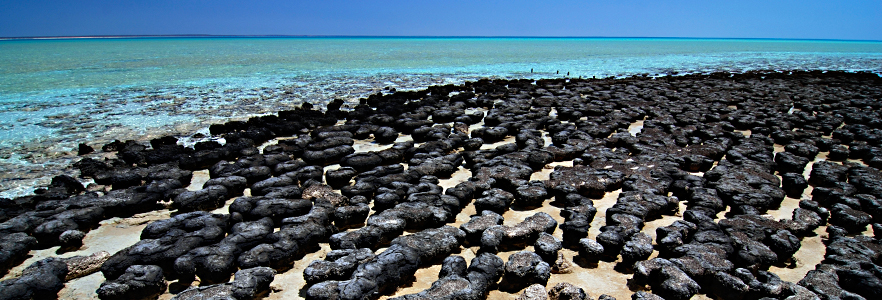Many of us are accustomed to observing our world on the scale permitted by our eyes. Unless its denizens are causing illness, we tend not to consider the microbiological world, a vast domain of life occupied by unicellular organisms that are too small to be seen with the naked eye.

Despite being tiny, bacteria can produce biofilms such as the plaque on your teeth, which are highly organised colonies that are capable of producing effects on an architectural scale. In fact what were arguably the first buildings were likely to have been made by bacterial colonies that trapped minerals from their surroundings and/or fixed carbon from the atmosphere to produce solid materials.
You can see evidence of bacterial built rocks, known as stromatolites, in places like Shark Bay in Australia. Harnessing the synthetic capabilities of bacteria, to take local resources and convert them into useful building materials such as the calcite produced in bacterial self-healing concrete, could help us shape our urban environment and increase biodiversity.
But let’s begin by taking a step back. Most of the cells in our bodies are not our own but are in fact microbial. Some 500 to 1,000 different types of bacteria live on and in us. In terms of total numbers, there are 10 bacterial cells for every one of the human cells that make up our bodies. If we extrapolate this concept to the earth as a whole then we find that the mass of living micro organisms exceeds the total biomass of all larger plants and animals combined.
From our partners:
Microorganisms are the most ancient forms of life on Earth. For two billion years, most of its living history, they were the only living entities on our planet. As they evolved, microorganisms generated the key processes upon which all other forms of life rely – such as photosynthesis, through which Earth’s oxygen-rich atmosphere is generated.
Even today, when our focus is often drawn to rainforest destruction and the impact of this on higher plants, photosynthetic microbes generate up to half of the oxygen in the Earth’s atmosphere. And beyond photosynthesis, microbes are also indispensable to our planet’s ecology, breaking down and recycling the biological building blocks present in dead animals and plants, and acting as key mediators in all of the Earth’s vital global nutrient cycles.
Microorganisms inhabit and have adapted to every earthly ecological niche, from dry Antarctic valleys to deserts, and can be found thriving in rocks 5.3 km below the Earth’s surface. Living bacteria have even been isolated at altitudes up to nearly 80 km. It is inevitable then that these life forms will adapt to our own urban and built environments.
In fact, in these familiar settings microorganisms have established complex and thriving ecologies that are still largely ignored, despite our intimacy with these environments. For example, many of the roofs in our towns and cities have become covered in a dark patina of microbial growth. It might not look alive, but were we able to observe it with a microscope we would find an exotic and miniature forest inhabited by fungi, green algae and cyanobacteria. This ubiquitous but overlooked microbiological veneer is called the urban cryptobiotic crust (UCC).
To better understand such ecologies, there is the the concept of microgeography. Borrowing from psychogeography this is defined as ‘the study of the specific effects of the geographical environment on the behaviour of the overlooked, but ubiquitous and important, microflora of our urban landscapes’.
Through microgeography, the relationship between an urban environment and its microbial and human inhabitants is explored through informed observation and a variety of playful and inventive strategies. Its aim is to take pedestrians off their predictable macroscopic paths and jolt them into a new awareness of the urban microbiological landscape and observe just how closely our ‘civilisations’ are entangled.
Microgeography reveals the places where the boundaries between the microcosm and macrocosm have become visible through the impact of our activities on the urban microflora. It invites the observer to question the impact of human activity upon the urban microbiological landscape, and through this, to extrapolate the impact of our actions on the world beyond.
For example, we could use the UCC as an environmental pollutant monitor; we could harness the bioluminescence of bacteria to provide light in our living spaces; or we could capitalise on some strains’ ability to fix carbon. Bacteria offer us a tiny world of possibilities, and microgeography is attempting to explore them in order to create a new set of tools for design so that we can build more ecologically.
This article originally appeared in Arup.
















